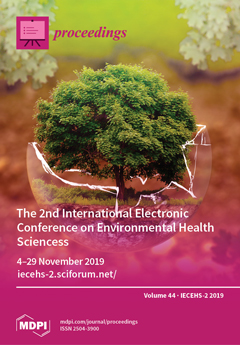Need Help?
Proceedings, 2020, IECEHS-2
The 2nd International Electronic Conference on Environmental Health Sciences
Online | 4–29 November 2019
Volume Editor: Jon Øyvind Odland, The Norwegian University for Science and Technology, Norway
- Issues are regarded as officially published after their release is announced to the table of contents alert mailing list.
- You may sign up for e-mail alerts to receive table of contents of newly released issues.
- PDF is the official format for papers published in both, html and pdf forms. To view the papers in pdf format, click on the "PDF Full-text" link, and use the free Adobe Reader to open them.
Cover Story (view full-size image):
This volume of Proceedings gathers the papers presented at the 2nd International Electronic Conference on Environmental Health Sciences (IECEHS-2 2019). The health of the next generation is of great
[...] Read more.
This volume of Proceedings gathers the papers presented at the 2nd International Electronic Conference on Environmental Health Sciences (IECEHS-2 2019). The health of the next generation is of great interest to us. This makes it necessary to continuously monitor environmental pollution and the related potential health effects. The information gathered from risk assessment studies is also important for policy makers to identify preventive measures to be adopted at both population and individual levels. The precautionary principle should be the basis of all environmental health science approaches based on newly acquired knowledge, including risk assessments and the definition of strategies to reduce contaminant exposure to humans. This conference creates a unique opportunity to discuss any subject related to environment and health issues.
Previous Issue
Next Issue
Issue View Metrics
Multiple requests from the same IP address are counted as one view.



